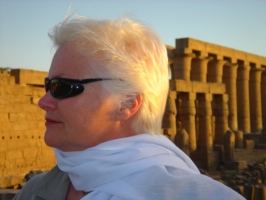Sometimes you fool yourself into thinking you’ve pretty much seen all the gorgeous art there is to see. You’ve seen towering sculptures by Michelangelo. You’ve seen the sketch-like brushwork of Fragonard. You’ve marveled at the pastels of Cassatt, and you’ve looked goggle-eyed at works by Van Gogh, Soutine, Lautrec, and Monet. I just hadn’t realized some works of medieval needlepoint would take my breath away.
The Musee National du Moyen Age–the National Museum of the Middle Ages–better known as the Cluny Museum, is a Left Bank treasure of stone heads, Byzantine ivories and altarpieces, stained glass, fabrics, and tapestries. This museum is in a medieval house built on top of Roman baths (one of three sets on the Left Bank) on busy Boulevards St. Germain-des-Pres and St. Michel. “The Cluny” may be built of stone, but at its heart are works of sublime beauty: the six tapestries of the Lady and the Unicorn.Â
Â
The tapestries of the “cycle” of La Dame a la licorne–The Lady and the Unicorn–were woven in Belgium out of silk and wool in about 1490. They are all about 12 feet high and are hung in the Cluny in a quiet, low-lit room where I sat on a padded bench. These magnificent works were absolutely stunning with the silence, the medieval lighting, and the monumental scale of the needlework.
Five of the tapestries depict the senses–taste, hearing, sight, smell, and touch. A sixth, called A mon seul désir (to my only desire), is interpreted as representing love or understanding. Each needlepoint shows a noblewoman with the unicorn on her left and a lion on her right.

The tapestries were rediscovered in 1841 in Boussac castle where they had been suffering damage from their storage conditions, and the tapestries have resided at the Cluny since 1882.
Not only are these pieces of needlework masterpieces of craftsmanship, but they are, incredibly, exhibited all together. The taste tapestery is not in Brussels and the hearing tapestry is not in Paris and the touch tapestry is not in Amsterdam. They’re all six here in this one museum room in Paris.
But the symbolism of each of the tapestries wasn’t so important to me. What washes over the museum visitors is the fabulous reds, blues, golds, and greens; the graceful cartooning giving each woman such grace; and the enormous size of these skillful pieces. Left alone in the room for a few minutes with these magnificent works of art was one of my best artistic experiences in Paris.
I’ve held needlepoint projects in my lap. They’re tricky to work on, especially in the middle. I can’t imagine how an artisan worked on the middle bits of these huge pieces. I can’t imagine how they were rolled up, over and over, as the artists and craftspeople worked for years on each section.

Many people have used “Lady and the Unicorn” in designs beyond needlepoint. The designs are found on watches, CD art, ornaments, and towels. Tracy Chevalier has written a book of the same name. All bear the gorgeous colors and graceful forms of this Flemish needlework. Those modern forms aside, I will always treasure my few minutes alone with the unicorns, lions, and ladies in the Cluny.







One Comment